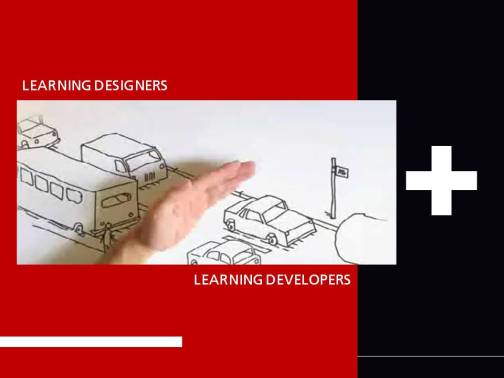This could be a story about buggy whips. You might know the classic management tale of the craftsman who was proud of building the most handsome and useful whips to spur on carriage horses at the turn of the last century. Unfortunately, as you you probably know the tale, carriages once replaced by the automobile rendered his lovely product useless.
I have watched from the trenches and sidelines as classes of learning professionals are now being divided —again by technology into two camps; those who know how learning should be constructed and craft it and those who can manufacture, at time and cost savings, the actual product.
Learning designers strategize how to solve problems to achieve performance improvement applying theory to fact and constructing course elements, flows and production processes. They gain agreement with stakeholders about content, audience, time on learning and assessment and the larger components of an experience. They scaffold the project so each step falls into place in a logical progression. In some cases, the learning designer will offer a narrative reflecting the content back to the stakeholders to ensure the critical content is captured. Additionally they might also write the actual storyboard incorporating the elements including the interactive and experiential (as well as social) elements that will make the course interesting if not compelling. The best and greatest courseware, the most inventive and exciting depends on a designer who can sculpt content into a story, then work with an interactive and/or graphic designer to sharpen the user experience across multiple platforms finally passing the work to a developer to program—as designed—for implementation.
Developers are those folks who know how to use the tools chosen by the enterprise to express content online in an effective and dynamic format. For the past number of years, while learning theory and ideas about making courses exciting have evolved growing with the speed and bandwidth available for elements like video, developer tools have been refined exponentially. Think of the industrial model—build an assembly line, now improve the assembly line and the tools—then make better products. However, this works well only when everything being made is a replica set to standardized requirements. Learning is not like that. Even when producing multiple courses with similar content, the opportunity to breathe excitement into each one is more present when designers do what they do best and developers express it. No template, no matter how sophisticated can allow for all the shadings required by great learning. Instead developers take the tools and either use them out of the box or, as I saw in a number of organizations, create, and in most cases struggle to build work-arounds expressing the designers intent while trying for hours to keep within the constraints of the software. An entire industry has been built around PowerPoint (by example) as the foundation for programs like Articulate. And the tide is with them since money flows downhill from big corporate enterprises and their subordinate constituencies. Better, faster, cheaper. And good enough.
The precedent for this was the explosive improvement in desktop publishing more than a decade back; once an associate learned the software they could generate print materials. The problem—and the connection to the current argument, is simply that these folks were not trained as graphic designers. The results spoke for themselves; a lot of bad design, quickly produced and reproduced. Moreover, when it was accepted by many managers as ‘good enough’ the die was cast for the attitudes we see now in learning design and development.
Here lies the collision and connection: In the hopes that ‘rapid’ eLearning cannot only reduce the time to create courseware the tools, ever more nuanced, allow developers to become designers as well. It’s seductive; managers cut down head count, more work can be pushed out the door by learning groups under pressure to deliver fast changing content, and costs drop when the designer, a more highly trained, often senior and knowledgeable resource can be set aside or redeployed. I don’t believe there has been a study conducted on performance improvement or even a Kirkpatrick view of which types of courses yield intended results. But I do know anecdotally that learning designed courses, where each professional works to their strength always seem to have an A-ha factor. Most other courses—those of the template kind—are utilitarian and though they might satisfy the requirements or outcomes, learner satisfaction cannot compare. This is dangerous and grows more so every day as multi-generational learners want different kinds of learning experiences.
The facts are there is room at the learning table for both types of development. However, there is no real lobbying group or organized industry to support the learning designer model. My fear is that learning and instructional design preparation will move even further towards the industrial model, templatized learning produced by individuals whose preparation has introduced them to a fair amount about learning…and the skillsets demanded to operate the tools. Unfortunately, there is too much complexity and uniqueness in learning to allow for excellence when this mashup becomes the status quo.
Those of us who have grown up in the era of learning design are more than ever segregated from access to development. Even with HTML5 used by great developers who can customize components to meet learning design objectives with wonderful precision, I see a rending of the system that will soon go the way of the buggy whip. So much of life today, from the professional sphere to just everyday life seems to be populated by people who figure that good enough is just that. Time is precious, financial strains are everywhere, the speed of life is overtaking the human ability to sustain its own sense of equilibrium in a world of instant everything. So let it go and accept the outlier will be the customization of learning only when absolutely defended by insistent clients with the budget and care to desire excellence. Otherwise, wait for tools to exhibit their next iteration, artificial intelligence.


